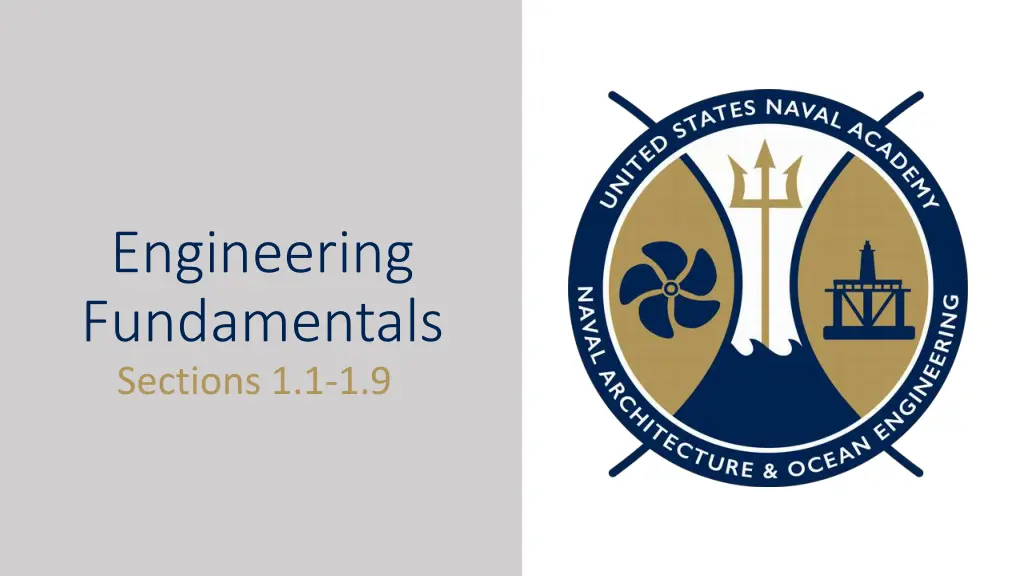
Fundamentals of Engineering: Unit Systems, Analysis, and Significance
Dive into the essentials of engineering with topics covering unit systems, unit analysis, significant figures, and more. Learn about key conversions, the importance of unit consistency in calculations, and the significance of significant figures in measurements.
Download Presentation

Please find below an Image/Link to download the presentation.
The content on the website is provided AS IS for your information and personal use only. It may not be sold, licensed, or shared on other websites without obtaining consent from the author. If you encounter any issues during the download, it is possible that the publisher has removed the file from their server.
You are allowed to download the files provided on this website for personal or commercial use, subject to the condition that they are used lawfully. All files are the property of their respective owners.
The content on the website is provided AS IS for your information and personal use only. It may not be sold, licensed, or shared on other websites without obtaining consent from the author.
E N D
Presentation Transcript
Engineering Fundamentals Sections 1.1-1.9
Powerpoint Guidance The powerpoints for EN400 provide an overview of the topics of this course, with emphasis on major subjects and examples to cover during class time The intent is for the slides to be paired with the textbook provided to cover all required information (available digitally online on the Course Website - https://www.usna.edu/NAOE/academics/en400.php ) DO NOT rely solely on the powerpoints to succeed in EN400 Actively take notes on lectures Ask questions Practice with homework problems Read the textbook for clarification / amplifying information on topics
Unit Systems S.I. (The International System of Units) International System Newton (force), kg (mass), meter (length), second (time) English System Thermodynamics and heat transfer Pound Force (lbf), Pound Mass (lbm) British Gravitational System (BGS) what we will use in EN400! pound-slug system Pound (force), slug (mass), foot (length), second (time)
Unit Systems Carry units through all calculations If the units are wrong, the answer is wrong Units can help with problem solving
Unit Analysis Key Conversions LT = Lieutenant = Naval Officer, O-3 LT = a long ton = British Ton, a unit of weight in Naval Architecture 1 LT = 2240 lb (on equation sheet) Fun fact = a ton = a short ton (English units) = 2000 lb
Unit Analysis If you get unreasonable values: Check the units in the process of calculations To avoid mistakes: Know the units of each parameter Understand the relationship between fundamental dimensions and their units
Unit Analysis Example Density of Sea Water ( ) Gravity (g) LT to lb conversion
Significant Figures (Sig Figs) Represent the number of reliable digits Exact numbers Infinite number of sig figs (e.g. 5 apples) Measurements Depend on the accuracy and precision of the measuring device (mechanical gage on a ship)
Significant Figures (Sig Figs) The number of accurate digits in a number Example: 2.65 has 3 significant figure Example: 10 has 1, 10. has 2 , 10.0 has 3 Addition/Subtraction Result has same # of sig figs as the LEAST decimal places Example: 3.6 + 1.212 = 4.8 Multiplication/Division Result has same # of sig figs as the LEAST precise factor (round after all math complete) Example: 21 x 3.444 = 72
General Problem Solving Technique 1. Write down applicable reference equation which contains the desired answer variable A. Solve the reference equation for the answer variable B. Write down additional reference equations and solve for unknown variables in the answer variable equation, if needed 2. Draw a quick sketch to show what information is given and needed and identify variables, if applicable 3. Rewrite answer variable equation, substituting numeric values with units for variables 4. Simplify this expanded equation, including units, to arrive at the final answer. 5. Check the answer: A. Do units match answer? B. Is the answer on the right order of magnitude?
Hydrostatic Pressure Pressure is the amount of force applied to a given area (p=F/A) In English units it is pounds/sq. ft. or pounds/sq. in., or psi Air pressure is ~ 15 psi At 440 ft below sea level it is ~ 195 psi! (~44 psi per 100 ft)
Hydrostatic Pressure & Force If an object is floating in water and the object and water are both at rest, then the pressure exerted by the water on the object is referred to as hydrostatic pressure and is defined as: Phyd = gzwhere = water density (lb-s2/ft4) g = acceleration of gravity (ft/s2) z = depth of object below thewater s surface (ft) Hydrostatic pressure acting over an area (A) results in a Hydrostatic Force where Fhyd = Phyd A.
Weighted Averages In Naval Architecture, we use the simplified form: In EN400, we will use this to find: Longitudinal Center of Flotation (LCF) Longitudinal Center of Buoyancy (LCB) Centers of Gravity (LCG, TCG, VCG (KG))
Translational vs. Rotational Motion Ship freely floating is subject to 6 degrees of freedom Three are Translational: Heave (z) Sway (y) Surge (x) Three are Rotational: Yaw (z) Pitch / Trim (y) Roll / List / Heel (x)
Ships Axes and Degrees of Freedom z Surge x Heave Pitch/Trim Roll (x) / Pitch (y) Generic term for rotation around an axis List (x) / Trim (y) Rotation around axis due to weight shifts Heel (x) - Rotation around axis due to external forces (wind) Roll/List/Heel y Sway * You need to be able to replicate this diagram / define these terms! * Yaw
Example Problem A 50ft wide, 100ft long barge on an even keel is divided into forward and aft compartments by a transverse bulkhead 60ft aft of the bow. The barge weighs 100LT empty with an even weight distribution. The forward tank is then filled to a height of 5ft and the aft tank to a height of 4ft with oil ( =1.80lb-s /ft4) A. What is the total weight of the barge? B. At what point (fore and aft) would this weight be applied? C. Which degrees of freedom for the barge were affected by loading the oil and in what direction?
Example Answer Weightbow compt= gV = (1.80lb-s /ft4) (32.17ft/s )(50ft 60ft 5ft)(1LT/2240lb) = 388LT 60 ft 40 ft 5ft deep 4ft deep 50 ft Weightaft compt= gV =(1.80lb-s /ft4) (32.17ft/s )(50ft 40ft 4ft)(1LT/2240lb) =207LT Weighttotal=388LT+207LT+100LT =695LT
Example Answer Application point= weighted average 60 ft 40 ft [(100LT 50ft)+(388LT 30ft)+(207LT 80ft)] 695LT 5ft deep 4ft deep 50 ft = 47.8ft 388LT @30ft 207LT @80ft Barge became heavier Draft increased Barge sank in the heave direction. More weight was placed forward barge pitched forward. 100LT@50ft






















